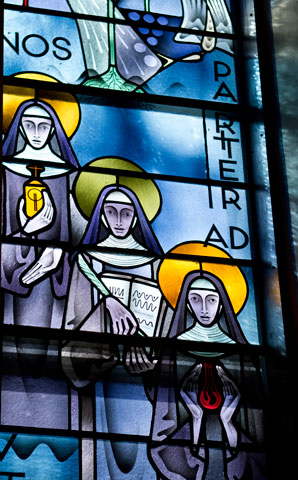
A window in the Mount St. Scholastica Chapel depicts three Benedictine saints: from left, Walburga, Hildegard and Gertrude. (Courtesy of Mount St. Scholastica)
 ATCHISON BLUE:A SEARCH FOR SILENCE, A SPIRITUAL HOME, AND A LIVING FAITH
ATCHISON BLUE:A SEARCH FOR SILENCE, A SPIRITUAL HOME, AND A LIVING FAITH
By Judith Valente
Published by Sorin Books, $15.95
If you come this way,
Taking any route, starting from anywhere.
At any time or at any season.
It would always be the same: you would have to put off
Sense and notion. You are not here to verify.
Instruct yourself, or inform curiosity,
Or carry report. You are here to kneel
Where prayer has been valid.
--T.S. Eliot, "Little Gidding"
T.S. Eliot's instructions to the visitor to Little Gidding apply equally to the 150-year-old Benedictine monastery of Mount St. Scholastica in Atchison, Kan. Here women religious have lived in community, helping to hold the world together through prayer. Atchison Blue is an appreciation of this community and a spiritual memoir of Judith Valente, a hard-driving journalist who lived with these women episodically for three years. The book's enigmatic title derives from the color of the stained glass windows of the monastery's chapel, which over the years have been changed to a unique blue-gray by the prairie's sun, rain and wind. Atchison blue stands as a metaphor for the transformation made possible by monastic life.
Valente's intent is double: to tell the story of the inner life of this community and to show how she was challenged to confront her own personal flaws. Throughout she illustrates how the Benedictine Rule and the goal of conversatio morum (the continuous conversion of life) serve these ends. For those who know the rhythm and ethos of monastic life, Valente's story will be a familiar one. For those who do not, Atchison Blue will serve as an introduction. The book is brief and the writing accessible and journalistic. Its tone is admiring of these women who offered Valente hospitality, and from whom she realized she had much to learn.
Valente arrives at the monastery beleaguered, anxious and exhausted. She is immediately startled by the saturating silence that surrounds her. As the alchemy of silence begins to transform, she discovers how the monastic day, regulated as it is by the chanting of the Hours, gives context and form to community life. Prayer becomes not some separate activity, but the day itself. She resonates with the alternating rhythms of work and leisure, the attention to detail and beauty, the care of each person, and the concern for the world beyond the monastery's walls. She encounters women who find meaning and zest in life, who form lifelong friendships, who are humble and filled with gratitude, and who have no fear of death. She is stunned by the conundrum that it is precisely their restriction that offers them great freedom.
In this context of love and care, almost by osmosis, Valente learns self-acceptance and an openness and vulnerability. She finds what she needs -- a "spiritual home" -- and gains the courage to face forthrightly her own limitations -- her striving, her resentments, her loneliness and fear of death. On the weeks during which she lives apart from Mount St. Scholastica, she tries to adapt what she learned to her daily life. In search of a "living faith" she calms her flickering mind by recitation of the Hours and by praying. Through these efforts she re-engages with her Catholic tradition and confronts her hopelessness over the church's scandals and the poverty of parish life. Ultimately, she joins these sisters as a Benedictine oblate, one who lives in the spirit of the Benedictine Rule while engaged in family and professional life.
Valente demonstrates the hidden treasures of monastic life -- the gift of silence, the value of community, and the order and meaning given by a life of prayer. What would have made this story more poignant was discussion of two painful realities confronting every community of women religious. What do these good women think about the stark reality that their way of life will have largely disappeared in the next two decades? How do they understand their institutional demise? And what is their response to the scurrilous questioning of women religious by the church hierarchy? These questions of necessity have shaped and formed these sisters and their community as well, causing them suffering. But like the prairie wind and sun, this suffering may make their Atchison blue even more translucent.
[Dana Greene is author of biographies of Evelyn Underhill, Maisie Ward and Denise Levertov and serves on the board of the Shalem Institute.]



